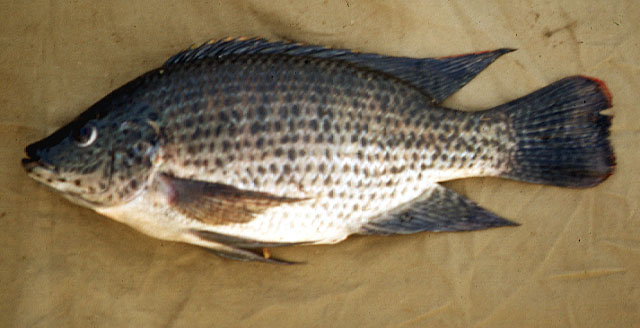| Cichlidae (Cichlids), subfamily: Pseudocrenilabrinae |
| 50 cm SL (male/unsexed) |
|
benthopelagic; freshwater |
| Africa: Pangani River in Kenya and Tanzania (Ref. 2, 52331, 118630), from Lake Jipe down to the Pangani Falls dam (Ref. 118638). Introduced in ponds at Korogwe (Ref. 2), thence distributed to several ponds and dams in Tanzania (Ref. 2, 54836), including near Tanga (Ref. 2), in the Usambara Mountains (Ref. 2), in Lake Singida (Ref. 2, 54836), and in dams near Dodoma (Ref. 54836). |
|
Dorsal spines (total): 17-19; Dorsal soft rays (total): 11-13; Anal spines: 3-4; Anal soft rays: 10-12; Vertebrae: 32-33. Diagnosis: A large bodied tilapia, with a slender body and small head and mouth; body depth 2.5-2.8 times in standard length (Ref. 4967, 118638). It can be distinguished by following characters: teeth of jaws with slender shafts in young, uniformly slender in adults; pharyngeal teeth very fine and crowded; dentigerous area with rounded lobes and short apex, its median length nearly always less than that of the blade; pectoral fin 34.3-41.2% of standard length, reaching base of anal fin; anal spines III-V (Ref. 2, 55060). Males and females are characterised by rows of blotched scales across the flanks; males have a pale blue head with dark spots, dark fins with pale spots, and orange margins to the dorsal and caudal; females and non-territorial males plainer and typically paler, and in some populations there is a more olive/yellow gular and ventral region (Ref. 118638). Caudal fin long with very definite vertical black or dark brown stripes (Ref. 55060).
Description: The upper profile of the head is steep and approximately straight (Ref. 2). The mouth is small and the jaws are not enlarged in most fishes; the teeth of the jaws are in 5-7 series in adults, very slender, up to half the posterior outer of the upper jaw becoming unicuspid in bigger fishes, inner tricuspid except the inmost row in a specimen of 203 mm standard length, which includes several unicuspids (Ref. 2). Two rows of scales on the cheek; number of scales in the lateral line series 33-36; scales on chest very small; on the belly the median row and three on each side of it noticeably smaller than the flank scales (Ref. 2). Dorsal fin with XVII-XIX spines and 11-13 soft rays; anal fin with III-IV spines and 10-12 soft rays (Ref. 2). Vertebrae 32-33 (Ref. 2). No genital tassel (Ref. 55060).
Colouration: Non-breeding fishes light grey or grey-green with numerous dark brown or black spots, each on one scale, but of irregular sizes and shapes, and some scales unmarked; seven to nine vertical bars on the body and a mid-lateral longitudinal band generally formed by emphasis of the spots; scales of belly pale with dark edges; spots extending on top and sides of head to varying degrees, often strong at the temporal lateral line pores; dorsal fin with dark spots or reticulum on the spinous part, oblique bars on the soft; anal barred posteriorly; caudal with vertical dark bars proximally, sometimes becoming irregular or fading out distally (Ref. 2, 55060). Mature male with green and purple sheen on the body, cheeks and opercula; dorsal margin bright orange, caudal margin crimson; pelvics and often also edge of anal bluish green; yellow spots on the dorsal and anal fin, and caudal fin yellow to orange; the dark mottlings on the flanks become more intense during aggressive or courting behaviour (Ref. 2). In life the dark spots are accompanied by golden-yellow spots (Ref. 2). The young have 9-14 dark vertical bars on the body, stretching from dorsal to ventral surface, caudal and hind end of anal striped as in adults (Ref. 2, 55060). A well marked black Tilapia-mark on a clear background extending from last dorsal spine to the third or fourth soft ray, and followed by 3 definite black bars on hind end of dorsal fin (Ref. 55060). |
| Found in lakes and rivers (Ref. 4967). Chiefly a browser of periphyton in the lake, but additionally feeding also on bottom deposits and associated phytobenthos (Ref. 30832). A maternal mouthbrooder (Ref. 54046, 55060, 118638). Occasionally territorial (Ref. 2). It supports artisanal fisheries in lakes and dams across the Pangani catchment, with the largest fisheries in Lake Jipe and Nyumba ya Mungu (Ref. 118638). IUCN conservation status is critically endangered due to its restricted range and evidence of declining stocks between the 1970s and 2000 (Ref. 118638). |
|
Endangered (EN); Date assessed: 23 June 2022 (B1ab(i,ii,iii)) Ref. (130435)
|
| harmless |
Source and more info: www.fishbase.org. For personal, classroom, and other internal use only. Not for publication.

